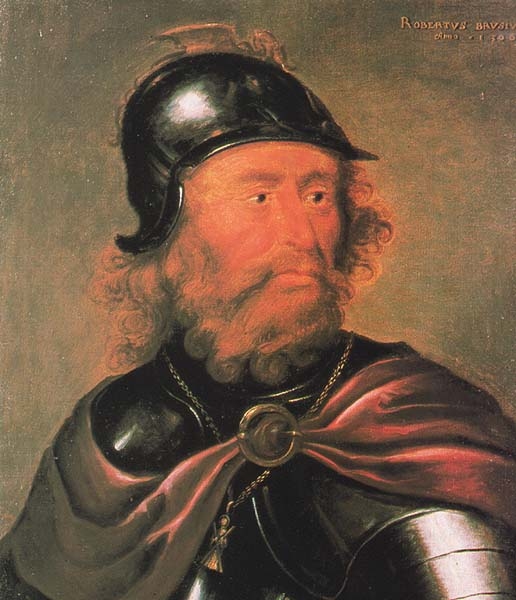
As with the other border abbeys, the first two hundred years were those of peace and productivity; an era which ended abruptly in 1296 as a new, unwelcome, era was ushered in from the south. For the next two hundred and fifty years, beginning with the war of independence and ending with the Rough Wooing, Melrose suffered the burden of border warfare.
In 1322 Melrose was sacked by Edward II's army. King Robert the Bruce assisted in the rebuilding of the abbey. A month before he died in 1329, Bruce instructed that his heart be buried within the abbey. In 1996 during archaeological excavations near the Chapter House a lead canister was discovered which, after careful examination, was found to contain a smaller medieval casket containing an embalmed heart, believed to be that of Robert the Bruce.
The casket has since been reburied in the grounds and is marked by a small stone bearing an engraved heart crossed by the saltire of the national flag and the inscription "A noble hart may have nane ease, gif freedom failye." (A noble heart may have no ease, if freedom fails.)
After fully exploring the impressive remains of the church, we wander through the less complete ruins of the monastery buildings – the kitchen, dormitories, refectory and chapter house. Most of these are little more than low walls, remains of the original outer walls of the buildings. The grounds of Melrose are bisected by a modern day road which we cross to visit the Commendator's House, a 15th century structure which was converted to a private house in 1590 and later became an exhibit building.
We stop on the path to the exhibition building, watching as a groundskeeper trims an overgrowth of grass away from the main drain, with meticulous care. The main drain is connected to the mill-lade which is fed by a dam across the Tweed. Part of its function in the middle ages was to power the abbey's mills, but before it reached the abbey buildings, part of it was diverted and carried along the main drain to flush the latrines. Beyond the drain, in the lay brothers range, tanning pits are visible – a physical reminder of Rievaulx Abbey, Melrose's mother house.
Inside the exhibit are several large carvings that have fallen from the walls of the abbey over time. Up a creaking staircase are glass display cases filled with artifacts that have been uncovered during excavations over the years. An impressive collection of intact ceramic vessels (urinals used by the abbots and lay brothers) fill one case. Corbels and ceiling bosses hang from the walls.
Time has caught up with us – morning is gone and it's just after noon as we head for the petrol station in Melrose to fill up for our long drive west and north. We say our good-byes to Melrose and before long we're out in the countryside, driving along on the A72 toward Peebles.

King Robert the Bruce's heart is said to have been buried at Melrose Abbey, perhaps brought back from a crusade in either 1330 or 1331. The position was marked by a small metal plaque.
In 1996 an archaeological excavation on the site unearthed a conical lead container and an engraved copper plaque that read "The enclosed leaden casket containing a heart was found beneath Chapter House floor, March 1921, by His Majesty's Office of Works." The casket contained a still recognisable human heart in a thick black liquor.
As there are no records of anyone else's heart being buried at Melrose it was presumed to be that of Robert the Bruce. The container was reburied at Melrose Abbey on 22 June 1998 under a memorial stone.
Read more about Melrose Abbey at Wikipedia.